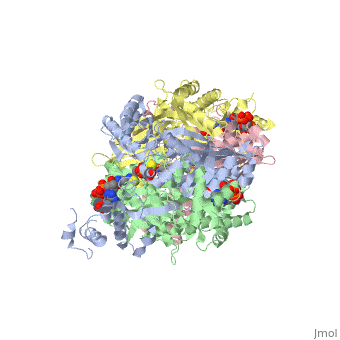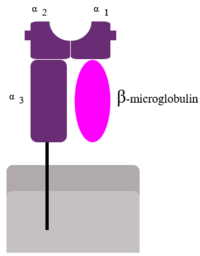Human beta two microglobulin
From Proteopedia
(Difference between revisions)
| (6 intermediate revisions not shown.) | |||
| Line 1: | Line 1: | ||
| - | <StructureSection load='1dq8' size=' | + | <StructureSection load='1dq8' size='400' side='right' caption='Crystal Structure of the Human Beta-2 Microglobulin (PDB entry [[1lds]])' scene=''> |
| - | ==Beta two microglubulin in human class I major histocompatibility complex (MHCb2m)== | + | ===Beta two microglubulin in human class I major histocompatibility complex (MHCb2m)=== |
| + | [[Image:MHC Class 1.png|200px|left]] | ||
| + | {{Clear}} | ||
Human β2-Microglobulin is the non-covalently bound <scene name='Human_beta_two_microglobulin/Light_chain/2'>light chain</scene> | Human β2-Microglobulin is the non-covalently bound <scene name='Human_beta_two_microglobulin/Light_chain/2'>light chain</scene> | ||
of the human class I | of the human class I | ||
| Line 9: | Line 11: | ||
typical properties of amyloid fibrils, principally in the joints and connective tissue. | typical properties of amyloid fibrils, principally in the joints and connective tissue. | ||
| - | ==Monomeric human b2m (Mhb2m)== | + | ===Monomeric human b2m (Mhb2m)=== |
The first crystal structure of Monomeric human b2m (Mhb2m) is solved in 2002 (pdb 1LDS). The protein is 99 residue in length and has a seven-stranded β sandwich fold typical of the Immunoglobulin superfamily. It is stabilized by a single disulfide bond between | The first crystal structure of Monomeric human b2m (Mhb2m) is solved in 2002 (pdb 1LDS). The protein is 99 residue in length and has a seven-stranded β sandwich fold typical of the Immunoglobulin superfamily. It is stabilized by a single disulfide bond between | ||
Cys-25 and Cys-80, which links the two β sheets. | Cys-25 and Cys-80, which links the two β sheets. | ||
| - | ==Structural comparison of MHCb2m and Mhb2m== | + | ===Structural comparison of MHCb2m and Mhb2m=== |
Both of the two strucures adopt seven-stranded β sandwich fold with a short C' β strand located in the loop connecting strands C | Both of the two strucures adopt seven-stranded β sandwich fold with a short C' β strand located in the loop connecting strands C | ||
and D. The most significant difference in the ctrystal structures of Mhb2m and MHCb2m involves residues in β strand D and the succeeding loop. When complexed with the MHC heavy chain, residues 50-56 of MHCb2m form two short β strands that separated by a two residue β bulge. These strands (depicted as D1 and D2 in Fig.1) each forms three main-chain-main-chain hydrogen bonds to the adjacent β strand E. The bulge in MHCb2m effectively twists the edge strand, which facilitate its binding to the surface of the heavy chain. However, this β bulge no longer exits in the crytal strucure of Mhb2m. The <scene name='Human_beta_two_microglobulin/D_strand/1'>conformation of D strand </scene>in Mhb2m provides an ideal assembly surface, making this edge-strand pair vulnerable to aggregation. The hydrogen-bonding potential of strand D is satisfied by the formation intermolecular interactionswith adjecent molecules, demonstrating the potential for this region to propagate assembly through edge-strand interactions. | and D. The most significant difference in the ctrystal structures of Mhb2m and MHCb2m involves residues in β strand D and the succeeding loop. When complexed with the MHC heavy chain, residues 50-56 of MHCb2m form two short β strands that separated by a two residue β bulge. These strands (depicted as D1 and D2 in Fig.1) each forms three main-chain-main-chain hydrogen bonds to the adjacent β strand E. The bulge in MHCb2m effectively twists the edge strand, which facilitate its binding to the surface of the heavy chain. However, this β bulge no longer exits in the crytal strucure of Mhb2m. The <scene name='Human_beta_two_microglobulin/D_strand/1'>conformation of D strand </scene>in Mhb2m provides an ideal assembly surface, making this edge-strand pair vulnerable to aggregation. The hydrogen-bonding potential of strand D is satisfied by the formation intermolecular interactionswith adjecent molecules, demonstrating the potential for this region to propagate assembly through edge-strand interactions. | ||
| - | In addition, the changes observed in strand D result in differenr orientations of the side chains of residues 50-54. As a result, | ||
| - | His-51 (which points inwards in the structure of MHCb2m) rotates by approximately 180, such that it now points away from the hydrophobic core of the protein. This would remove the second protevtive feature from the edge strand, facilitating further interaction in this region (Fig.2). | ||
| - | + | In addition, the changes observed in strand D result in differenr orientations of the side chains of residues 50-54. As a result, His-51 (which points inwards in the structure of MHCb2m) rotates by approximately 180, such that it now points away from the hydrophobic core of the protein. This would remove the second protevtive feature from the edge strand, facilitating further interaction in this region (Fig.2). | |
| + | |||
| + | __NOTOC__ | ||
=Amyloid Fibril formation of Mhb2m= | =Amyloid Fibril formation of Mhb2m= | ||
==Mhb2m fiber formation conditions== | ==Mhb2m fiber formation conditions== | ||
| Line 36: | Line 38: | ||
In separate studies b2m has been shown to form oligomers and fibrils at neutral pH by addition of Cu2+ and 1 M urea. This induces the formation of a non-native species, called M*, that appears identical to IT by size exclusion chromatography (SEC). Coordination of the metal ion promotes peptide bond isomerisation at Pro32, and the subsequent rapid formation of oligomers as | In separate studies b2m has been shown to form oligomers and fibrils at neutral pH by addition of Cu2+ and 1 M urea. This induces the formation of a non-native species, called M*, that appears identical to IT by size exclusion chromatography (SEC). Coordination of the metal ion promotes peptide bond isomerisation at Pro32, and the subsequent rapid formation of oligomers as | ||
judged by SEC, providing further supporting evidence that the isomerisation of Pro32 is a key initial step on the pathway to fibrils.Structural studies of the trapped folding intermediate, IT (orM*), have provided molecular insights into the possible aggregation mechanisms of b2m at neutral pH. For example, crystallographic data for the mutant, P32A shows that this conformer results in substantial reorganisation of aromatic side-chains that are present in the core of the native protein. In this structure, a number of aromatic and hydrophobic residues are displaced including Phe30, Phe56, Trp60, Phe62, Tyr63 and Leu54. These rearrangements present a strip of exposed hydrophobic residues on the protein surface, providing a possible avenue for protein aggregation (Fig.3). This species crystallises as a dimer underlining its potential to form intermolecular interactions. | judged by SEC, providing further supporting evidence that the isomerisation of Pro32 is a key initial step on the pathway to fibrils.Structural studies of the trapped folding intermediate, IT (orM*), have provided molecular insights into the possible aggregation mechanisms of b2m at neutral pH. For example, crystallographic data for the mutant, P32A shows that this conformer results in substantial reorganisation of aromatic side-chains that are present in the core of the native protein. In this structure, a number of aromatic and hydrophobic residues are displaced including Phe30, Phe56, Trp60, Phe62, Tyr63 and Leu54. These rearrangements present a strip of exposed hydrophobic residues on the protein surface, providing a possible avenue for protein aggregation (Fig.3). This species crystallises as a dimer underlining its potential to form intermolecular interactions. | ||
| - | |||
==Fibrillar architecture== | ==Fibrillar architecture== | ||
In aqueous solution at neutral or acidic condition, amyloid-like fibrils are formed from b2m that show a long-straight, left-hand twisted and unbranched morphology when observed by EM and AFM (Fig.4) | In aqueous solution at neutral or acidic condition, amyloid-like fibrils are formed from b2m that show a long-straight, left-hand twisted and unbranched morphology when observed by EM and AFM (Fig.4) | ||
| - | |||
===A unifying mechanism of b2m fibril formation=== | ===A unifying mechanism of b2m fibril formation=== | ||
| Line 47: | Line 47: | ||
to a similar fibrillar product. This could occur by unfolding of native b2m to allow reorganisation of the protein structure; or by | to a similar fibrillar product. This could occur by unfolding of native b2m to allow reorganisation of the protein structure; or by | ||
refolding of the highly dynamic polypeptide chain at pH 2.5 to a more structurally ordered intermediate species (Fig.5). | refolding of the highly dynamic polypeptide chain at pH 2.5 to a more structurally ordered intermediate species (Fig.5). | ||
| - | |||
| - | |||
| - | |||
| - | |||
| - | |||
| - | |||
Similarities between the assembly mechanisms are supported by several reasons: | Similarities between the assembly mechanisms are supported by several reasons: | ||
| Line 60: | Line 54: | ||
#.An additional common characteristic is that many variants capable of fibril formation at neutral pH have the effect of destabilising the Nterminal region of the protein, which is also highly unfolded in the structural ensembles formed at low pH. | #.An additional common characteristic is that many variants capable of fibril formation at neutral pH have the effect of destabilising the Nterminal region of the protein, which is also highly unfolded in the structural ensembles formed at low pH. | ||
#. The role of trans Pro32 in fibril formation at low pH is currently unknown, although 80% of the molecules would be expected to contain the trans conformation in the acid denatured state. Moreover, the observation that the rate of fibril formation of P32G is similar to that of wild-type b2m when studied at pH 2.5 is suggestive of a common trans amyloid precursor. | #. The role of trans Pro32 in fibril formation at low pH is currently unknown, although 80% of the molecules would be expected to contain the trans conformation in the acid denatured state. Moreover, the observation that the rate of fibril formation of P32G is similar to that of wild-type b2m when studied at pH 2.5 is suggestive of a common trans amyloid precursor. | ||
| - | + | </StructureSection> | |
==3D structures of beta-2 microglobulin== | ==3D structures of beta-2 microglobulin== | ||
Current revision
| |||||||||||
3D structures of beta-2 microglobulin
References
- Amyloid formation by globular proteins under native conditions. Nature chemical biology,5,15(2009) [1]
- Crystal structure of monomeric human β-2-microglobulin reveals clues to its amyloidogenic properties. PNAS,99,9771(2002) [2]
- A regulatable switch mediates self-association in an immunoglobulin fold. Nature structural & molecular biology,15,965(2008) [3]
- A native to amyloidogenic transition regulated by a beckbone trigger. Nature structural & molecular biology, 13,202(2006) [4]
- Glimpse of the molecular mechanism of β2-microglobulin fibril formation in vitro: Aggregation on a complex energy landscape. FEBS letters, 583,2623(2009) [5]


